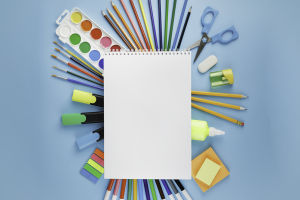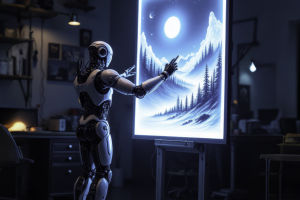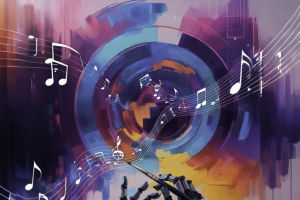Lykkers, can you identify what all these careers have in common: Social Media Manager, Podcast Producer, Mobile App Developer, Virtual Assistant, 3D Printer Technician, and Content Marketer?
They are all linked to technology, but 15 years ago many of these jobs did not exist.
It is only in the last decade that digital art has begun to gain attention and popularity as people started to appreciate intricate and impactful artwork created using digital technology. Illustrations, animations, 2D and 3D art, and other forms of digital art are gaining increasing recognition due to their unique quality, depth, and impact.
A study conducted by the Institute for the Future (IFTF) concludes that 85% of the jobs that will exist in 2030 have not been created yet. All these careers will exist due to the ever-changing nature of technology. It is something that is not going away, and that is why more and more schools are incorporating digital arts curricula.
According to the 2019 State of Art Education Survey, 52.2% of art teachers want to learn more about effectively teaching digital art. However, only 21.9% of art teachers feel comfortable teaching a digital arts curriculum.
The desire and need to teach the digital medium are there, but is it really important to teach? Will digital art replace traditional art?
What is Digital Art?
Some artists use materials like colors and brushes to create art. Today, many others also use modern means to explore creativity, such as video technology, television, and computers. This type of art is called digital art.
Digital art is work done with digital technology or presented on digital technology. This includes images made entirely on a computer or hand-drawn images scanned into a computer and finished using software programs like Adobe Illustrator. Digital art can also involve animations and rendering of virtual 3D sculptures, as well as projects that combine different technologies. Some digital arts involve the manipulation of video images.
The term "digital art" was first used in the 1980s in relation to an early computer painting program. It is a method of making art that lends itself to a multimedia format because it can potentially be viewed in many ways, including on TV and the internet, on computers, and across multiple social media platforms. In short, digital art is a kind of fusion between art and technology. It allows for many new ways of making art.
The Origins of Digital Art
Digital art could not exist without computers. Those machines that are so familiar to us today had their beginnings in the 1940s when the first true computer, the Electronic Numerical Integrator and Computer. Artists began exploring the possibilities of art using computers and related technologies in the late 1950s and early 1960s.
One of the first truly digital artworks was created in 1967 by Americans Kenneth Knowlton and Leon Harmon. They took a photograph of a woman and transformed it into an image composed of computer dots. A dot is a small element of an image—when many dots are combined, they can create a larger, complete image. This was one of the first digital art pieces.
The Importance of Digital Arts
Some see technology as a threat to originality and as an attempt to replace traditional art-making. This idea can certainly be concerning for art teachers. However, studies suggest that using digital tools in art education enhances artistic development and creativity. In a digital age, art teachers feel the need, now more than ever, to defend their programs. A digital arts curriculum can serve as a powerful defense tool.
Why Traditional Art is Also Important
Digital art does not require fewer skills than traditional art, but it requires a different way of thinking. Yes, a digital device will have the ability to make a brushstroke appear and layer like watercolor or give the texture of a charcoal drawing. However, when one learns traditional artistic techniques, a deeper understanding of materials and what they can do is gained.
There are many benefits to traditional methods of art-making:
1. Hands-on experiences
2. Unique pieces
3. Greater versatility
4. Problem-solving resolution
Embracing Digital Art in Education
There is no magic in digital tools. The magic comes from how we teach our students to enhance their creativity. Generations before us have used new technologies in different forms. Using chalk on chalkboards and pencils on paper were once new ideas. Taking a dull worksheet and putting it on an iPad doesn't make it exciting; it will still be dull.
Exceptional learning can happen with or without advanced technologies, but when done well, it can enhance experiences. If you are not ready to fully immerse yourself in the world of technology, look for ways you can ease into it. Instead of completely replacing traditional methods of art-making, look for ways to enhance them.
A digital approach could improve the process. For example, teaching perspective drawing at one point can be cumbersome, but learning it digitally might make the process easier while learning the same concepts. Creativity will be the skill of the future.
How to Infuse Digital Art into Your Curriculum
There are various types of graphic tablets that fit different artistic styles depending on the medium used. Once you familiarize yourself with the key features and specifications of a basic tablet, you can choose a model that suits your preferred artistic style. There are multiple factors that influence the quality and functionality of a drawing tablet.
Some key points to remember before buying one - digital pen sensitivity is extremely important as it can make or break your artwork, screen size especially if you are used to working on a particular canvas size, resolution, responsiveness, pen type, and advanced features among others. A graphics tablet is the lifeline of every digital artist. There are not many pen tablet manufacturers out there, and Wacom's pen display represents about 60%-70% of the Japanese market. However, there are pen tablets from other manufacturers available, such as XP-PEN.
Digital art is not a replacement for traditional art but an evolution that expands creative possibilities. As technology continues to shape the future, embracing digital tools in education and professional art careers will be essential.
By blending traditional techniques with digital advancements, artists can unlock new dimensions of creativity and innovation. The future of art lies in adaptability, and those who harness both worlds will lead the way in this ever-evolving landscape.


